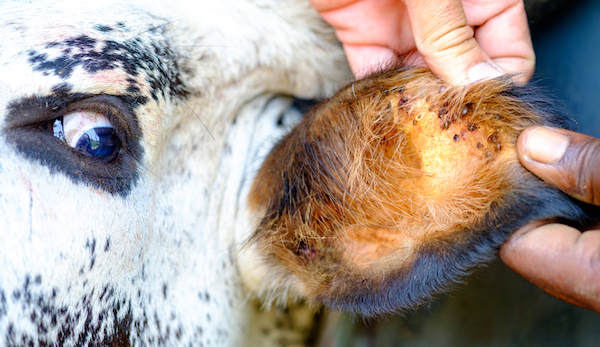Cattle producers need to be aware of a potentially fatal disease known as “Ikeda” that is currently circulating in several states. The disease is transmitted via Asian longhorned ticks, which have been confirmed in 17 US states. Ikeda has been identified in 12 of those so far and is blamed for the death of at least two bulls in Kentucky recently.
Ikeda is actually caused by a parasite known as Theileria orientalis (Ikeda genotype) that infects red and white blood cells, leading to chronic anemia in infected cattle and other bovines. Clinical signs of theileriosis are similar to anaplasmosis in cattle and include anemia, jaundice, and weakness. Native genotypes of T. orientalis in the United States are usually nonpathogenic. However, the genotype Ikeda strain is novel to most US cattle. Ikeda has only been documented in the US since September 2017 but has been afflicting cattle herds in Australia and New Zealand for around two decades.
The loss potential from Ikeda is not insignificant, with herd infections reporting mortality rates as high as 5%. The disease also spreads rapidly and herd infection can reach 80% within 30 days. The good news is that once the disease stabilizes in the exposed herd, deaths tend to drop to near zero, though new naive herd additions (meaning cattle that have never been exposed to the disease) will still be susceptible. Cattle that survive infection usually become lifelong carriers of the disease. Meaning once a herd contracts it, it is nearly impossible to eradicate.
Theileria sporozoites (the infective stage) are transmitted to susceptible animals during tick feeding through the tick’s saliva, or through needles that have been used on an infected animal, then a naive animal. If environmental temperatures are high, infective sporozoites can develop in ticks on the ground without a host. Ticks can also remain infected on a pasture for up to 2 years under favorable conditions.
The Asian longhorned ticks (AHLT) that transmit the parasite are very tiny and hard to spot on cattle, much like deer ticks. Once AHLT are introduced to a suitable habitat, populations can increase rapidly due to the fact that the females are parthenogenetic,, meaning they can reproduce without mating. ALHT was first found in the US in New Jersey in 2017 and has migrated outward ever since. The presence of the ticks has so far been confirmed in Arkansas, Connecticut, Delaware, Georgia, Kentucky, Maryland, Missouri, New Jersey, New York, North Carolina, Ohio, Pennsylvania, Rhode Island, South Carolina, Tennessee, Virginia, and West Virginia.
Unfortunately, there is no approved vaccine for Ikeda, nor any effective clinical treatment. That makes prevention and biosecurity measures the most effective course of action. The Virginia Cooperative Extension has produced a helpful guide titled “Managing the Asian Longhorned Tick: Checklist for Best Management Practices for Cattle Producers” that can be accessed HERE.
General tips include inspecting cattle for ticks regularly, monitoring your herd’s weight gain and any behavioral changes, chemical controls, and proper herd management techniques. Animal disease experts say it is also important that movement of the Asian longhorned tick is documented to prevent disease. If you suspect the ticks in your area, USDA recommends contacting your veterinarian or extension agent. (Sources: USDA, University of Tennessee, Virginia Cooperative Extension)








